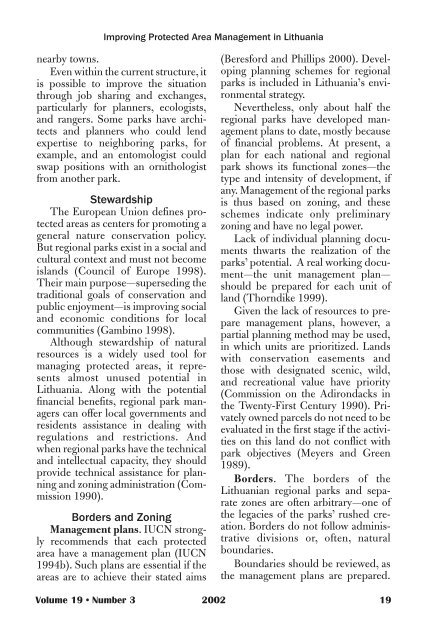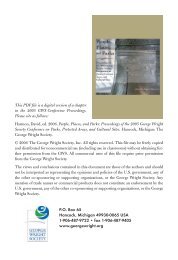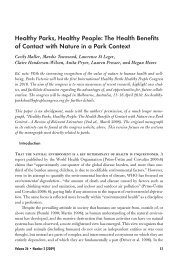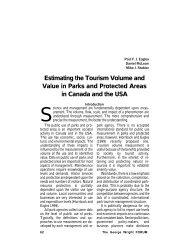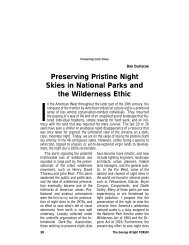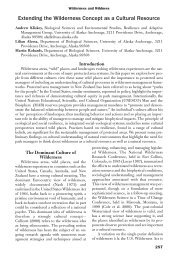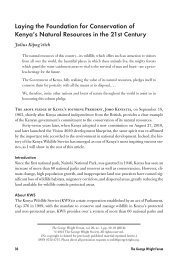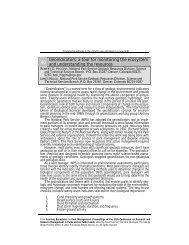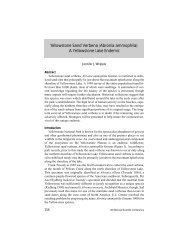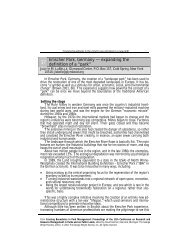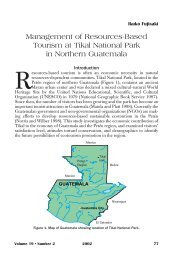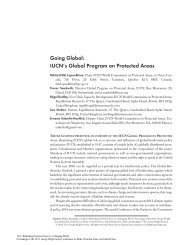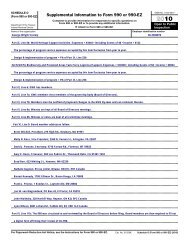Improving Protected Area Management in Lithuania - The George ...
Improving Protected Area Management in Lithuania - The George ...
Improving Protected Area Management in Lithuania - The George ...
You also want an ePaper? Increase the reach of your titles
YUMPU automatically turns print PDFs into web optimized ePapers that Google loves.
<strong>Improv<strong>in</strong>g</strong> <strong>Protected</strong> <strong>Area</strong> <strong>Management</strong> <strong>in</strong> <strong>Lithuania</strong><br />
nearby towns.<br />
Even with<strong>in</strong> the current structure, it<br />
is possible to improve the situation<br />
through job shar<strong>in</strong>g and exchanges,<br />
particularly for planners, ecologists,<br />
and rangers. Some parks have architects<br />
and planners who could lend<br />
expertise to neighbor<strong>in</strong>g parks, for<br />
example, and an entomologist could<br />
swap positions with an ornithologist<br />
from another park.<br />
Stewardship<br />
<strong>The</strong> European Union def<strong>in</strong>es protected<br />
areas as centers for promot<strong>in</strong>g a<br />
general nature conservation policy.<br />
But regional parks exist <strong>in</strong> a social and<br />
cultural context and must not become<br />
islands (Council of Europe 1998).<br />
<strong>The</strong>ir ma<strong>in</strong> purpose—supersed<strong>in</strong>g the<br />
traditional goals of conservation and<br />
public enjoyment—is improv<strong>in</strong>g social<br />
and economic conditions for local<br />
communities (Gamb<strong>in</strong>o 1998).<br />
Although stewardship of natural<br />
resources is a widely used tool for<br />
manag<strong>in</strong>g protected areas, it represents<br />
almost unused potential <strong>in</strong><br />
<strong>Lithuania</strong>. Along with the potential<br />
f<strong>in</strong>ancial benefits, regional park managers<br />
can offer local governments and<br />
residents assistance <strong>in</strong> deal<strong>in</strong>g with<br />
regulations and restrictions. And<br />
when regional parks have the technical<br />
and <strong>in</strong>tellectual capacity, they should<br />
provide technical assistance for plann<strong>in</strong>g<br />
and zon<strong>in</strong>g adm<strong>in</strong>istration (Commission<br />
1990).<br />
Borders and Zon<strong>in</strong>g<br />
<strong>Management</strong> plans. IUCN strongly<br />
recommends that each protected<br />
area have a management plan (IUCN<br />
1994b). Such plans are essential if the<br />
areas are to achieve their stated aims<br />
(Beresford and Phillips 2000). Develop<strong>in</strong>g<br />
plann<strong>in</strong>g schemes for regional<br />
parks is <strong>in</strong>cluded <strong>in</strong> <strong>Lithuania</strong>’s environmental<br />
strategy.<br />
Nevertheless, only about half the<br />
regional parks have developed management<br />
plans to date, mostly because<br />
of f<strong>in</strong>ancial problems. At present, a<br />
plan for each national and regional<br />
park shows its functional zones—the<br />
type and <strong>in</strong>tensity of development, if<br />
any. <strong>Management</strong> of the regional parks<br />
is thus based on zon<strong>in</strong>g, and these<br />
schemes <strong>in</strong>dicate only prelim<strong>in</strong>ary<br />
zon<strong>in</strong>g and have no legal power.<br />
Lack of <strong>in</strong>dividual plann<strong>in</strong>g documents<br />
thwarts the realization of the<br />
parks’ potential. A real work<strong>in</strong>g document—the<br />
unit management plan—<br />
should be prepared for each unit of<br />
land (Thorndike 1999).<br />
Given the lack of resources to prepare<br />
management plans, however, a<br />
partial plann<strong>in</strong>g method may be used,<br />
<strong>in</strong> which units are prioritized. Lands<br />
with conservation easements and<br />
those with designated scenic, wild,<br />
and recreational value have priority<br />
(Commission on the Adirondacks <strong>in</strong><br />
the Twenty-First Century 1990). Privately<br />
owned parcels do not need to be<br />
evaluated <strong>in</strong> the first stage if the activities<br />
on this land do not conflict with<br />
park objectives (Meyers and Green<br />
1989).<br />
Borders. <strong>The</strong> borders of the<br />
<strong>Lithuania</strong>n regional parks and separate<br />
zones are often arbitrary—one of<br />
the legacies of the parks’ rushed creation.<br />
Borders do not follow adm<strong>in</strong>istrative<br />
divisions or, often, natural<br />
boundaries.<br />
Boundaries should be reviewed, as<br />
the management plans are prepared.<br />
Volume 19 • Number 3 2002 19


